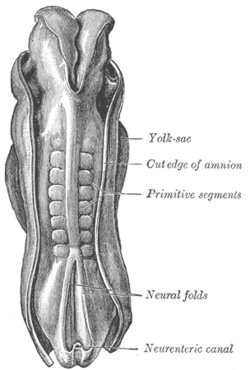Segmentation in biology refers to the division of some animal and plant body plans into a series of repetitive segments. This article focuses on the segmentation of animal body plans, specifically using the examples of the phyla Arthropoda, Chordata, and Annelida. These three phyla form segments by using a “growth zone†to direct and define the segments. While all three have a generally segmented body plan and use a “growth zone,†they use different mechanisms for generating this patterning. Even within these phyla, different organisms have different mechanisms for segmenting the body. Segmentation of the body plan is important for allowing free movement and development of certain body parts. It also allows for regeneration in specific individuals.
Definition

Segmentation is a difficult process to satisfactorily define. Many taxa (for instance the molluscs) have some form of serial repetition in their units, but are not conventionally thought of as segmented. Segmented animals are those considered to have organs that were repeated, or to have a body composed of self-similar units, but usually it is the parts of an organism that are referred to as being segmented.
Animals

Segmentation in animals typically falls into three types characteristic of different arthropods, vertebrates, and annelids. The arthropod fruit fly forms segments from a field of equivalent cells based on transcription factor gradients. The vertebrate zebrafish uses oscillating gene expression to define segments known as somites. The annelid leech uses smaller blast cells budded off from large teloblast cells to define segments.
Arthropods: Drosophila
Although Drosophila segmentation is not representative of the arthropod phylum in general, it is the most highly studied. The drosophila as a model organism is ideal for genetic screens. Early screens to identify genes involved in cuticle development led to the discovery of a class of genes that was necessary for proper segmentation of the drosophila embryo.
To properly segment the drosophila embryo, the anterior-posterior axis is defined by maternally supplied transcripts giving rise to gradients of these proteins. This gradient then defines the expression pattern for gap genes, which set up the boundaries between the different segments. The gradients produced from gap gene expression then define the expression pattern for the pair-rule genes. The pair-rule genes are mostly transcription factors, expressed in regular stripes down the length of the embryo. These transcription factors then regulate the expression of segment polarity genes, which define the polarity of each segment. Boundaries and identities of each segment are later defined.
Within the arthropods, the body wall, nervous system, kidneys, muscles and body cavity are segmented, as are the appendages (when they are present). Some of these elements (e.g. musculature) are not segmented in their sister taxon, the onychophora.
Annelids: Leech
While not as well studied as in drosophila and zebrafish, segmentation in leech has been described as “budding†segmentation. Early divisions within the leech embryo result in teloblast cells, which are stem cells that divide asymmetrically to create bandlets of blast cells. Furthermore, there are five different teloblast lineages (N, M, O, P, and Q), with one set for each side of the midline. The N and Q lineages contribute two blast cells for each segment, while the M, O, and P lineages only contribute one cell per segment. Finally, the number of segments within the embryo is defined by the number of divisions and blast cells. Segmentation appears to be regulated by the gene Hedgehog, suggesting its common evolutionary origin in the ancestor of arthropods and annelids.
Within the annelids, as with the arthropods, the body wall, nervous system, kidneys, muscles and body cavity are generally segmented. However, this is not true for all of the traits all of the time: many lack segmentation in the body wall, coelom and musculature.
Chordates: Zebrafish
Although perhaps not as well studied as Drosophila, segmentation in zebrafish is actively studied. The process is similar in zebrafish and other chordates, such as the chicken and the mouse. Segmentation in chordates is characterized as the formation of a pair of somites on either side of the midline. This is often referred to as somitogenesis.
In the zebrafish, segmentation is coordinated by the clock and wavefront model. The “clock†refers to the periodic oscillation of specific genes, such as Her1, a hairy/Enhancer of split- gene. Expression starts at the posterior end of the embryo and moves towards the anterior. The “wavefront†refers to the location where the somites mature, which is defined by gradients of retinoic acid and FGF. Retinoic acid is high in the anterior and FGF is high in the posterior; the “wavefront†is the point at which both concentrations are at their lowest. Cells at this point will mature and form a pair of somites.
Other taxa
In other taxa, there is some evidence of segmentation in some organs, but this segmentation is not pervasive to the full list of organs mentioned above for arthropods and annelids. One might think of the serially repeated units in many Cycloneuralia, or the segmented body armature of the chitons (which is not accompanied by a segmented coelom).
Origin
Segmentation can be seen as originating in two ways. To caricature, the 'amplification' pathway would involve a single-segment ancestral organism becoming segmented by repeating itself. This seems implausible, and the 'parcellization' framework is generally preferred â€" where existing organization of organ systems is 'formalized' from loosely-defined packets into more rigid segments. As such, organisms with a loosely defined metamerism, whether internal (as some molluscs) or external (as onychophora), can be seen as 'precursors' to eusegmented organisms such as annelids or arthropods.
See also
- Metamerism
- Pharyngeal arch
- Rhombomere
References

